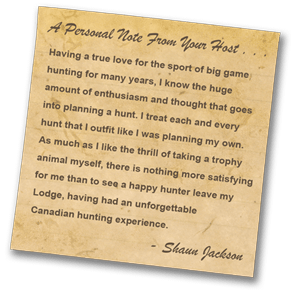A hunt with Jackson's includes:
- Very comfortable accommodations in modern cabins
- Hot and cold running water and showers
- Return air transportation from Lac du Bonnet airbase
- Professional guides with many years of experience
- Home-cooked meals provided during your stay
| Bear | Moose |
|---|---|
| $3895 / hunter | $7655 / hunter |

Black Bear
- Length: 4.5-8 feet (1.4-2.4 metres)
- Height at the shoulder: 2.5-3 feet (0.8-1 metre)
- Weight: 300-500 (135-227 kg.)
This medium-sized bear is usually black with a brown muzzle, lacks a shoulder hump, and often has a white patch on the chest. Although black is the predominant color, chocolate and cinnamon brown color phases are also common, which often results in people confusing them with brown bears.
Black Bears live primarily in forested areas and are very adapt at climbing trees. A Black Bear uses its front paws to wrap around the tree and then use's the hind paw’s claws to dig into the tree. Black Bears are solitary animals except for a mother with cubs. The average lifespan of a black bear in the wild is 20 years.
A Black Bears eyesight and hearing is about the same as human's but their olfactory system is about a hundred times more sensitive that a human’s. Their sense of smell is so acute that they can locate their prey from miles (kilometres) away. They use their sense of smell to locate food and mates during the breeding season. Black Bears are classified as carnivores and do hunt other animals but for the most part their diet is comprised of plants like fruits, berries and nuts.

Reproduction
The Hunt
Our spring and fall bear hunts are conducted from our full-service American Plan Lodge on Amphibian Lake. Similar to our moose hunts, we have exclusive hunting rights in this area covering a large portion of land. Our spring hunt runs from the last week of May until the second week of June. Our fall hunt begins the second week of August and continues until the end of September.
Although we have a lot of area, we only conduct minimal spring and fall hunts from this location; and this is why we can boast such high success rates with many bears in the six-foot range. Although many of our larger bears are black, there is also a good chance that you could harvest a colour phase bear.
Your hunt will take place over well-established bait sites that have been pre-baited well in advance of your hunt. Each site has a large comfortable permanent tree stand. All of our bear guides have years of experience and will work extremely hard to ensure that your hunt is successful.
Moose
- Length: 8.5-10.5 feet (2.5-3.2 metres)
- Height at the shoulder: 5.5-7.5 feet (2-2.25 metres)
- Weight: 900-1,300 pounds (360-591 kg) with some even larger
Moose are the largest member of the deer family and the tallest wild mammal in North America. They are noted for long legs, a short neck, broadly palmate antlers, a prehensile muzzle and a dewlap or bell on the throat.
Moose are non-migratory ruminants that can consume up to 60 pounds of browse per day. They also make use of seasonally available pond plants and are capable of feeding well below the surface of the water. Moose are excellent swimmers. They are generally solitary.

Reproduction
Each year, beginning in April, a bull moose grows a set of antlers. These continue to grow all summer, and in the early fall they shed the velvet. The breeding season extends from September through October. Bull moose in rut do not gather a harem but mark out a territory to which cows will be attracted.The bull stays with one cow for a week or so before breaking off to find another.
During the rut, cows protect their calves from the very aggressive rutting bulls. The gestation period is about 8 months. The first pregnancy most often results in a single calf. In subsequent pregnancies, the female generally gives birth to twins. At birth a calf will weigh 20-25 lbs (9-11 kg). After the mating season, the bulls start losing their antlers, and this is generally completed by late January.
The Hunt
The Canadian Moose that we hunt in northeastern Manitoba are the second largest moose found in North America. In all of the areas that we hunt you will not be competing with other hunters as we have two unique features:
- These areas are only accessible by air.
- We hold all the non-resident hunting rights in these areas.
Our many years of experience has shown that the most important aspect of a successful hunt is having an expert guide that knows how to handle any situation that may arise during your hunt. We can only describe our guides as Simply the best. It would be difficult to find an experience more thrilling than hunting a huge Canadian moose during the rut season. To be able to call an animal of that size, with a massive rack to within a few yards of you, is simply AWESOME!
All of our non-resident hunting is conducted from our amazing full-service lodge at Amphibian Lake or from Harrop Lake Lodge. At Amphibian Lake you have access to Little Amphibian Lake, Hangar Lake, as well as the Pigeon River with your own personal guide. In addition to a first-class hunt you will also get to enjoy all of the great walleye and northern pike fishing that you can handle. A hunt of a lifetime awaits you!
